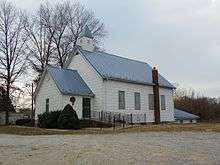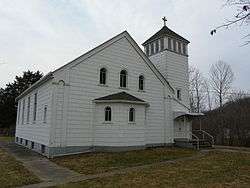Lithium, Missouri
| Lithium, Missouri | |
|---|---|
| Village | |
 Location of Lithium, Missouri | |
| Coordinates: 37°49′56″N 89°53′2″W / 37.83222°N 89.88389°WCoordinates: 37°49′56″N 89°53′2″W / 37.83222°N 89.88389°W | |
| Country | United States |
| State | Missouri |
| County | Perry |
| Township | Saline |
| Area[1] | |
| • Total | 0.06 sq mi (0.16 km2) |
| • Land | 0.06 sq mi (0.16 km2) |
| • Water | 0 sq mi (0 km2) |
| Elevation | 381 ft (116 m) |
| Population (2010)[2] | |
| • Total | 89 |
| • Density | 1,483.3/sq mi (572.7/km2) |
| Time zone | Central (CST) (UTC-6) |
| • Summer (DST) | CDT (UTC-5) |
| ZIP code | 63775 |
| Area code(s) | 573 |
| FIPS code | 29-43346[3] |
| GNIS feature ID | 0721146[4] |
Lithium is a village located in Perry County, Missouri. The population was 89 at the 2010 census. The 2000 Census found Lithium to have zero residents; an Associated Press article from 2001, however, states that about 50 people in fact reside there, but may have been counted as part of Perry County's rural population.
Lithium had a ZIP Code of 63775, but it has since been declared by the United States Postal Service to be "Not Acceptable - Use Perryville."
Name
Lithium's location is due to two natural mineral springs. One of the two springs contained lithium salts, giving the town its name.[5]
History
Lithium was first surveyed as a town in 1882. The first settlers were Dr. Henry Clay Tish, Richard P. Dobbs and James G. Christian, who all came to Missouri from Illinois. The town was incorporated in 1883 and the first mayor was Richard C. Lisenby. The location of the town was determined by 2 mineral springs, which were highly prized on account of their medicinal qualities, which led to the construction of a bath house by Thomas King in 1883. A Baptist church, Lithium Baptist, was organized in 1885 and a Catholic church, St. John the Evangelist, was organized in 1896. By 1912 the town had 2 general stores, 2 mills, a brick yard and population of 98.[6]
Geography
Lithium is located at 37°49'56" North, 89°53'1" West (37.832223, -89.883862).[7]
According to the United States Census Bureau, the village has a total area of 0.06 square miles (0.16 km2), all of it land.[1]
Location of nearby communities

Demographics
As of the census[3] of 2000, there were no people living in the village.
2010 census
As of the census[2] of 2010, there were 89 people, 28 households, and 22 families residing in the village. The population density was 1,483.3 inhabitants per square mile (572.7/km2). There were 32 housing units at an average density of 533.3 per square mile (205.9/km2). The racial makeup of the village was 98.88% White and 1.12% from other races. Hispanic or Latino of any race were 1.12% of the population.
There were 28 households of which 53.6% had children under the age of 18 living with them, 64.3% were married couples living together, 7.1% had a female householder with no husband present, 7.1% had a male householder with no wife present, and 21.4% were non-families. 7.1% of all households were made up of individuals and 3.6% had someone living alone who was 65 years of age or older. The average household size was 3.18 and the average family size was 3.27.
The median age in the village was 27.5 years. 34.8% of residents were under the age of 18; 9% were between the ages of 18 and 24; 25.7% were from 25 to 44; 20.2% were from 45 to 64; and 10.1% were 65 years of age or older. The gender makeup of the village was 57.3% male and 42.7% female.
Gallery
 Lithium Baptist Church
Lithium Baptist Church St. John the Evangelist Catholic Church
St. John the Evangelist Catholic Church
References
- 1 2 "US Gazetteer files 2010". United States Census Bureau. Retrieved 2012-07-08.
- 1 2 "American FactFinder". United States Census Bureau. Retrieved 2012-07-08.
- 1 2 "American FactFinder". United States Census Bureau. Retrieved 2008-01-31.
- ↑ "US Board on Geographic Names". United States Geological Survey. 2007-10-25. Retrieved 2008-01-31.
- ↑ State Historical Society of Missouri http://shs.umsystem.edu/manuscripts/ramsay/ramsay_perry.html
- ↑ History of southeast Missouri : a narrative account of its historical progress, its people and its principal interests https://archive.org/stream/historyofsouthea01doug/historyofsouthea01doug_djvu.txt
- ↑ "US Gazetteer files: 2010, 2000, and 1990". United States Census Bureau. 2011-02-12. Retrieved 2011-04-23.
